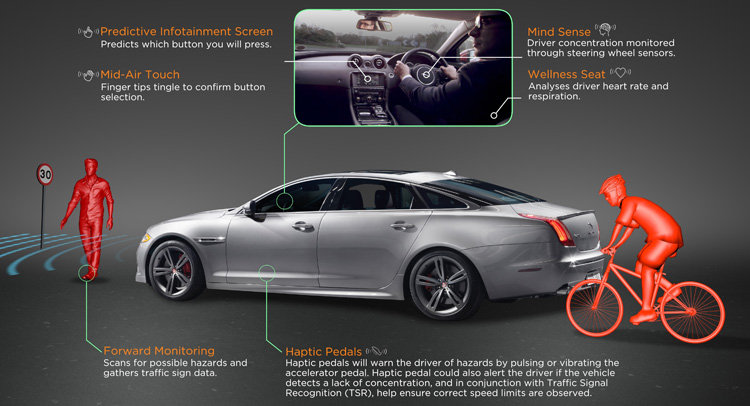Jaguar Land Rover is working on a project called ‘Mind Sense’, aimed at measuring brainwaves to monitor driver concentration in the car.
Currently being tested in a Jaguar XJ, the project’s purpose is to reduce the number of accidents caused by drivers who are stressed, distracted and not concentrating on the road ahead.
Mind Sense may allow a car to effectively read the brainwaves that indicate a driver is beginning to daydream, or feeling sleepy, whilst driving. So how would that work?
The human brain continually generates four or more distinct brainwaves at different frequencies. By continually monitoring which type of brainwave is dominant, an on-board computer could potentially assess whether a driver is focused, daydreaming, sleepy, or distracted.
Jaguar Land Rover is investigating a method already used by NASA to develop a pilot’s concentration skills. This detects brainwaves through the hands via sensors embedded in the steering wheel.
“If brain activity indicates a daydream or poor concentration, then the steering wheel or pedals could vibrate to raise the driver’s awareness and re-engage them with driving,” explains Jaguar Land Rover’s Director of Research and Technology, Dr Wolfgang Epple.
Another system JLR researchers are working on is called Driver Wellness Monitoring, which uses a medical-grade sensor embedded in the seat of a Jaguar XJ to monitor the well-being of the driver. The sensor detects vibrations from the driver’s heart beat and breathing. “If the car detects severe health issues, or simply how alert the driver is, then the car could take steps to ensure the driver is focused enough on the driving task to take over,” says Dr. Epple.
Also under development is the Predictive Infotainment Screen with mid-air touch, a technology which aims to increase the speed and efficiency of the interaction between the driver and the infotainment screen by predicting which button the driver intends to press. As a result, button selection could take place in mid-air, increasing the speed of the operation by 22 percent.
Finally, JLR is also working on a Haptic Accelerator Pedal, which could also be used to communicate with the driver. For example when he or she drives too fast, the pedal feel could offer increased feel resistance.














